Enquire Now!
"*" indicates required fields
"*" indicates required fields
"*" indicates required fields
"*" indicates required fields
Please complete this form and send your product(s) to:
Seahorse Equipment Limited
41 Whiore Ave, Tauriko
Tauranga 3110, New Zealand
"*" indicates required fields
Upload your favourite fishing pics, tell us a good yarn and you might get your story posted to our Facebook page or fishing gallery!
"*" indicates required fields
Please complete the form and we will send you a FREE brochure.
"*" indicates required fields
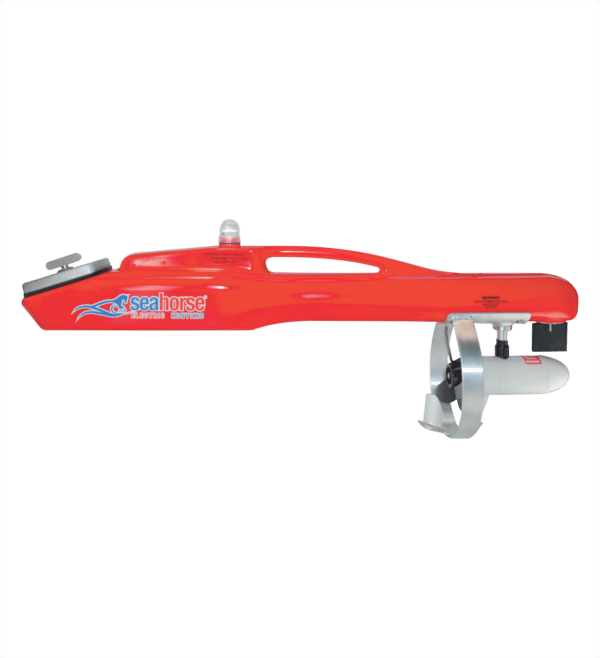
$3,500.00 inc GST
The GPS seahorse is the only Kontiki which will go where you point it. The built-in automated GPS controlled autopilot system will steer your Kontiki in the direction you want. No need to adjust for side currents or worry about large waves knocking it off course, a simple swipe with the magnet to set, and it does all the hard work for you, ensuring a perfect set each time.
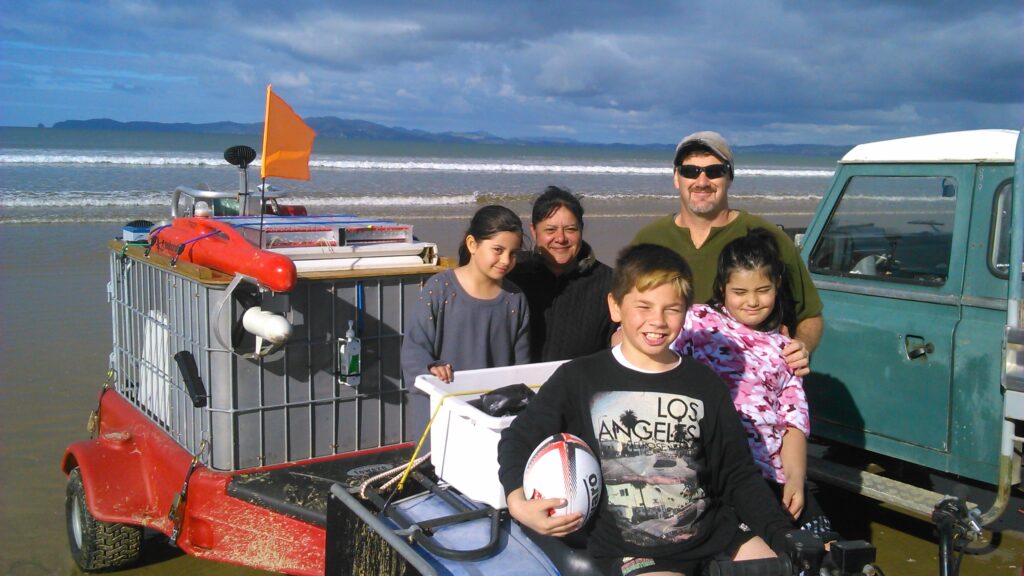
The GPS-controlled Autopilot in the GPS Seahorse uses technology developed by the Team at Seahorse to give the user ultimate control over the direction of their Seahorse Kontiki. Point it in the direction you wish it to travel in, and when ready, swipe the magnet over control. The course is set, and that’s where it will go. Once launched, the GPS-controlled autopilot will steer the GPS Seahorse along that course. If a side current exists, the autopilot will adjust and steer the Kontiki into the current so the selected course is maintained. If a wave knocks the Kontiki off course, it will be steered back onto the course.
This will allow the fisher to tackle large surf with the knowledge the GPS Seahorse will go straight out where they want. It’s the same with the busy East Coast Beaches. The Fisher can confidently launch, knowing their Seahorse will go where they pointed it. You will also be able to target specific areas of the seabed to improve your catch.
Seahorse has used a unique patented combination of compass and GPS technology to make the most accurate Kontiki autopilot ever!!. It is the only one that will go where you point it. Based on the ever-successful Seahorse Kontiki and over 13 years of Kontiki production, the GPS Seahorse Kontiki has many improved features that help it perform better than ever.
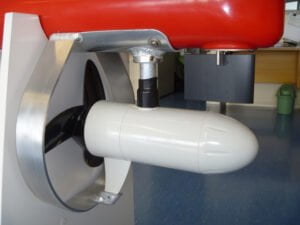
The success of any autopilot system is based on the rudder. Following proven yacht design principles, Seahorse has developed a balanced, hydro-dynamic-shaped rudder that will work in the rough and tumble of surf, where control is needed. The aerofoil shape of the rudder ensures it will work in the aerated water of the surf zone, compared to a flat metal plate rudder that will struggle to work in these conditions.
The GPS Seahorse body has been designed to move the rudder and motor as far forward as possible to ensure the best possible directional stability. Being forward, the rudder gets maximum leverage on the pivot point, allowing a smaller rudder to be used. This helps reduce drag, ensuring maximum distance.
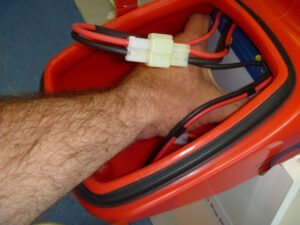
The hatch on the GPS Seahorse Kontiki is larger than on the existing STD Seahorse Kontiki.
This allows easy fitting and removal of the batteries, as it is now possible to put your hand into the Kontiki and hold the batteries as you insert or remove them. The access hole has a higher lip, with a bullnose ridge that holds the hatch seal in place. The newly designed hatch spider has three fingers to allow better and quicker fitting of the hatch.
This hatch is user-friendly, easy to use, and the most secure and best-selling hatch on the market.
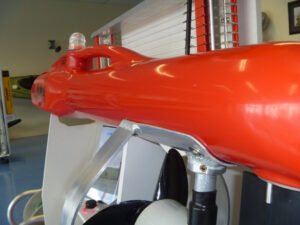
The body of the GPS Seahorses has been designed to ensure the Kontiki unit performs as
efficiently as possible to achieve levels of performance previously not possible. The new body directly develops the very successful Standard Seahorse Kontiki body. The body is very streamlined, allowing it to slide through the waves while staying balanced and level. The motor and rudder are as far forward as possible, which is the best location for keeping the Kontiki going straight. The handle is longer and balanced with or without batteries, making it easier to carry. The hatch is the largest possible to allow easy fitting and removal of the batteries, and the battery position perfectly balances the Kontiki unit in the water, so no power is lost bouncing around in the waves. The Seahorse Kontiki is one of the best-balanced cuts with a smooth path through the surf.
The Seahorse Kontiki units have no drag-producing fins or keels to slow the Kontiki down. The motor frame has a clean, simple design and is perfect for the job, and the flat bottom ensures the GPS Seahorse will stand and not fall over.
We started with the Standard Seahorse Kontiki, which has an incredible ability to self-steer through varying side currents and waves. This is a unique ability unmatched by others on the market. The long body length of the Seahorse Kontiki allows for unrivalled longitudinal steering stability. The offset tow point and the forward-mounted motor ensure maximum resistance from waves and rough conditions. The long, low body acts as a rudder, removing the need for drag-inducing keels or fins. The low buoyancy design also allows the Seahorse to dive under the breaking surf and avoid being washed off course. We have found the line towing behind the Seahorse Kontiki works like a kite’s tail, which helps keep the unit straight. The low drag, forward-mounted rudder allows the GPS Seahorse to steer and change direction, therefore keeping the Kontiki unit heading in the direction you pointed it in.
When Seahorse decided to develop an autopilot Kontiki unit, we looked at the different means of controlling direction. We first looked at using a compass, as this seemed an easy and simple way of doing it, but the more we looked into it, the more we discovered it wouldn’t do the job we wanted to be done. With a local Tauranga Boys High student, as part of his technology course, we built a prototype to test the concept, and that highlighted many issues.
We found the compass was good at selecting a course. Still, once the motor was started, it was impossible to get the compass further away from the motor and wires so it wasn’t affected while keeping the body of the Kontiki streamlined. We also found that if the compass got too close to the black iron sand, it affected the compass, so you got a different course when you set the course on the beach than once the Kontiki was in the water. The compass was further away from the magnetic iron sand.
We also found the compass kept the Kontiki unit following a compass bearing and side currents pulled it along the beach. This is because a compass knows where it is pointing but not where it is heading. We also found this behaviour removed the Kontiki unit’s ability to correct itself by tacking into the current, and the compass-controlled Kontiki ended up further along the beach compared to our standard Seahorse.
We finally decided to combine the two and use the strengths of each approach. We now use the compass to find and fix the bearing or course you want your Kontiki to follow, and we just the GPS technology to track the Kontiki’s progress along this course, and instruct the rudder to turn to keep everything on course.
When you develop the system on any beach, it will go where you point it. No one else can do this.
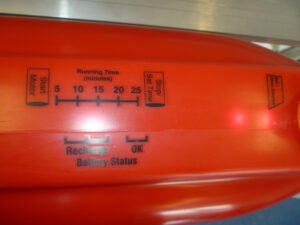
Much hard work and money was spent to make the autopilot function as easy as possible to operate. Place the GPS Seahorse Kontiki on the beach, pointing in the direction you wish it to travel. There is no need to adjust or allow side currents, as the GPS Seahorse will do that for you. Ensure the GPS Seahorse is clear of the winch and motor vehicles to ensure the electronic compass is not affected. Plug your batteries and attach your line. The GPS control unit takes 5 to 30 seconds to get a lock on the satellites, followed by another three seconds to get a solid bearing lock. The controller calculates the way-point the Kontiki will steer towards, and it also will show the two lights indicating the course is ready to be locked in. At this stage, you can lock the course in by swiping the magnet over the sensor, or if needed, the Kontiki can be moved to a new heading. If moved, the control panel will return to a single light, showing the autopilot is getting a lock on the new heading, and after three seconds, the two lights will indicate the course is calculated and ready for you to lock into place.
You can now set the time on the motor controller and launch the GPS Kontiki after the motor has been started.
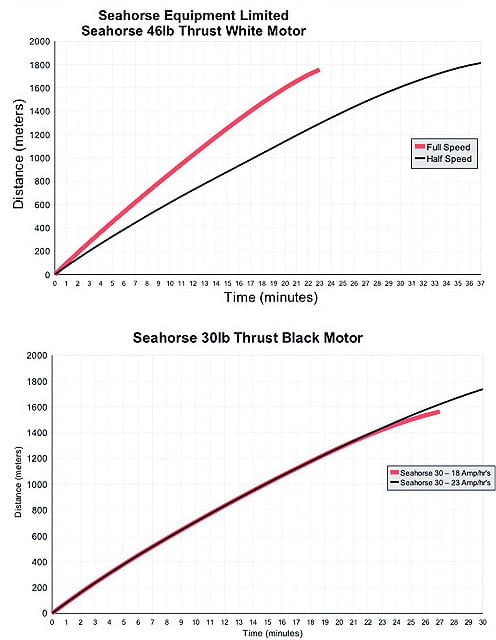
The Seahorse Electronic Motor Control Unit and the Autopilot control unit are resin-sealed. This resin block is fitted into the polyethene body and held in place with moulded anchor points. The electronics remove a mass of wiring, allowing a clean and simple battery compartment. Two connecting leads attach the two batteries.
On the motor control unit, a row of 10 super-bright LEDs, which shine through the body, indicates your battery status and will indicate if the batteries need charging. The LED lights show your Seahorse’s pre-selected running time. The amount of time is indicated by the number of LED lights illuminating a bar display. Once the time is set, start the Seahorse motor by putting the magnet near the START switch. You can run the Seahorse until the low battery cut-out switches it off or set the timer to 25, 20, 15, 10 or 5 minutes run time.
The LED flashes fast to show the motor is running, and on the Seahorse GPS 46, the lights will flash slowly to show when the slow speed is selected.
The Seahorse Kontiki is the only Kontiki with a built-in automatic stall protection system. If the motor is stalled, the control unit will automatically stop and start the motor up to three times, trying to dislodge the offending item—an essential feature for shingle beaches.
The graphs show the Seahorse Kontiki’s performance. They are based on the results from various runs recorded by GPS.
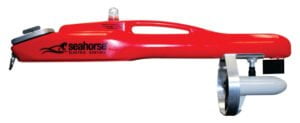 Seahorse Kontikis are professionally designed and constructed by our team to handle the harsh beach conditions of New Zealand. It’s imperative that everything is designed to operate in coastal elements such as sand, salt, and water. That is why all internal components, including the batteries, are fully sealed for maximum protection and to keep maintenance to a minimum. The Electronic Control Unit is encased in resin for protection.
Seahorse Kontikis are professionally designed and constructed by our team to handle the harsh beach conditions of New Zealand. It’s imperative that everything is designed to operate in coastal elements such as sand, salt, and water. That is why all internal components, including the batteries, are fully sealed for maximum protection and to keep maintenance to a minimum. The Electronic Control Unit is encased in resin for protection. The world-leading and New Zealand designed and built electronics bring a new level of technology to Kontiki fishing The GPS Seahorse uses the proven Seahorse Control Unit, and this is responsible for the management and protection of the batteries. It monitors the batteries and will stop the motor if the charge in the battery falls to a low level. It starts and stops the motor, and if a timed run is selected, the electronic timer is used to control the run. The control unit is operated externally by a magnet allowing it to be operated anywhere and in any conditions. The stall protection and recovery feature is an essential feature to protect the motor and batteries from the extensive damage a stalled motor can cause. If the motor is stalled, the control will stop and start the motor 3 times, trying to dislodge the offending item, and allow you to continue fishing. Shingle beaches, such as the Hawkes Bay, and sticks are a major cause of stalled motors.
The world-leading and New Zealand designed and built electronics bring a new level of technology to Kontiki fishing The GPS Seahorse uses the proven Seahorse Control Unit, and this is responsible for the management and protection of the batteries. It monitors the batteries and will stop the motor if the charge in the battery falls to a low level. It starts and stops the motor, and if a timed run is selected, the electronic timer is used to control the run. The control unit is operated externally by a magnet allowing it to be operated anywhere and in any conditions. The stall protection and recovery feature is an essential feature to protect the motor and batteries from the extensive damage a stalled motor can cause. If the motor is stalled, the control will stop and start the motor 3 times, trying to dislodge the offending item, and allow you to continue fishing. Shingle beaches, such as the Hawkes Bay, and sticks are a major cause of stalled motors.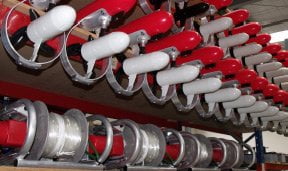 The control panel is designed for simple one-touch control right up to the moment of launching
The control panel is designed for simple one-touch control right up to the moment of launching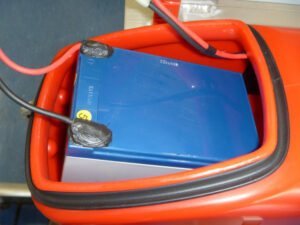 The batteries are accessed via the large completely watertight, sealed, submarine-styled, aluminium marine hatch designed by Seahorse. The hatch seals over a large surface area of the rubber seal. The Aluminium hatch provides a total seal without distorting out of shape as the tighter the hatch is closed, the stronger the seal becomes. The hatch seal sits against the inter ring of the body, allowing the hatch to apply the sealing pressure. We can guarantee this hatch will seal in conditions where other hatches fail. The large bull-nose lip holds the hatch seal securely in place. The hatch has a sealed stainless steel locking bolt, which cannot be over-tightened. The specially moulded battery box will hold the batteries securely in place, no matter how rough the surf gets. The low-down position of the batteries ensures the Seahorse Kontiki is always stable and upright.
The batteries are accessed via the large completely watertight, sealed, submarine-styled, aluminium marine hatch designed by Seahorse. The hatch seals over a large surface area of the rubber seal. The Aluminium hatch provides a total seal without distorting out of shape as the tighter the hatch is closed, the stronger the seal becomes. The hatch seal sits against the inter ring of the body, allowing the hatch to apply the sealing pressure. We can guarantee this hatch will seal in conditions where other hatches fail. The large bull-nose lip holds the hatch seal securely in place. The hatch has a sealed stainless steel locking bolt, which cannot be over-tightened. The specially moulded battery box will hold the batteries securely in place, no matter how rough the surf gets. The low-down position of the batteries ensures the Seahorse Kontiki is always stable and upright.Below are a selection of our instructional videos. To view all our videos, please go to the bottom of our resources page – click on the link, or view it below.
Reviews
There are no reviews yet.